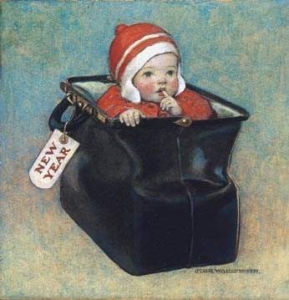
- Jessie Willcox Smith (1863-1935)|New Year’s Baby, 1910|Cover illustration for Good Housekeeping (January 1925)|watercolor, gouache, charcoal, and colored pencil on board|Thanks to American Illustrators Gallery, NYC
J. C. Leyendecker may be known for his yearly contributions to Saturday Evening Post covers of a baby heralding the new year, but others too have used the image of a baby for the same purpose.* One of the most charming is Jessie Willcox Smith’s cover illustration for the January 1925 Good Housekeeping magazine. According to the information on this painting currently held by the American Illustrators Gallery in New York, Smith painted this illustration in 1910, four years after Leyendecker created his first New Year baby.
It is a sweet rendition of the New Year baby, in this instance the baby is seated in a sizeable handbag with a label attached to it’s handle that reads, “New Year.” The baby is dressed in a red and white knit outfit of hat and sweater. The hat is a bit askew on the baby’s head, making the child appear more endearing rather than perfect. While drawn with a cute baby face, the gesture of the index finger lifted knowingly to the mouth is that of an older child. Smith merely shaded the background color of the image without indicating details of the space or furniture.
The image of a baby in a handbag is derived from Oscar Wilde’s (1854-1900) comic play, The Importance of Being Earnest. This play debuted in London on February 14, 1895. In a short 1910 article the New York Times references the play’s American premier in New York as having been shortly after the play was first produced in London at the St. James Theatre.** The play ran on and off in New York, Connecticut, and around Philadelphia through the first decade of the twentieth century depending upon the agreement of the owner of the U. S. rights to this comedy, so it is not hard to imagine that Jessie Willcox Smith would have known this play.
The farcical plot of The Importance of Being Earnest pivots on the name “Earnest” and describes in loving detail a baby boy mistakenly placed in a handbag while his governess’s three-volume novel manuscript replaced the boy in the baby buggy. At this revelation at the end of the third act in the play, the character in question, Jack, goes upstairs to retrieve the exact handbag in discussion.
Jack: Is this the handbag, Miss Prism? Examine it carefully before you speak. The happiness of more than one life depends on your answer.
Miss Prism: It seems to be mine. Yes, here is the injury it received through the upsetting of a Gower Street omnibus in younger and happier days. Here is the stain on the lining caused by the explosion of a temperance beverage, an incident that occurred at Leamington. And here, on the lock, are my initials. I had forgotten that in an extravagant mood I had had them placed there. The bag is undoubtedly mine. I am delighted to have it so unexpectedly restored to me. It has been a great inconvenience being without it all these years.
In the case of the Jessie Willcox Smith’s cover illustration, the handbag with its attached label signifies the gift of the new year, echoing the inherent promise of the new born. The bag is open at our feet, allowing the baby to appear. And there before us all, this innocent new year awaits our footprints and our actions.
* Between 1906 and 1943 J. C. Leyendecker created a new year’s baby cover for each new year issue of The Saturday Evening Post. Traditionally, the turn of the New Year is symbolically portrayed by the juxtaposition of a decrepit old man and an innocent baby.
** The New York Times (September 6, 1910). See https://query.nytimes.com/mem/archive-free/pdf?res=9F01E1D61230E233A25755C0A96F9C946196D6CF
January 7, 2010
By Joyce K. Schiller, Curator, Rockwell Center for American Visual Studies
Norman Rockwell Museum






